A Brief History of the
Coutts – Sweetgrass International Train Station
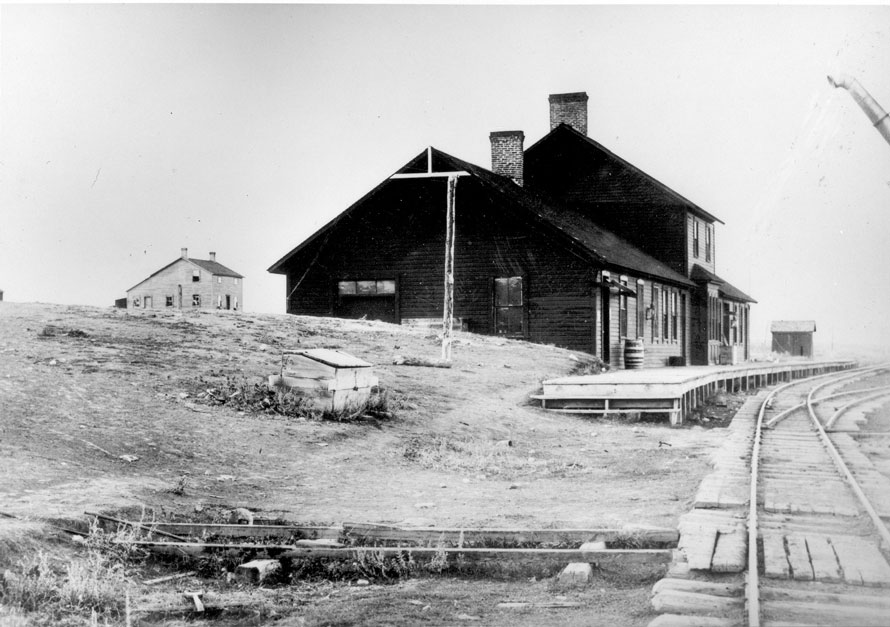
This is the story of a unique building (the only one we know of) – an international train station that was run by one family operating two railways in the Northwest Territories (pre-Alberta) and Montana and how it was almost lost in the redevelopment of the new border crossing at Coutts Alberta (AB) – Sweetgrass Montana (MT).
Background
In 1883, Sir Alexander Galt and his son Elliott co-founded the Town of Lethbridge, AB when he established a mine on the banks of the Oldman River in the southwest portion of the district of Alberta, Northwest Territories. Galt is a well-known figure in the Lethbridge area where a public park (Galt Gardens) and a museum (Galt Museum and Archives) are named after him. Canada’s then Governor General, the Marquis of Lansdowne, demonstrated the Government’s support of the Galt enterprises by opening the Galt’s railway in September 1885.
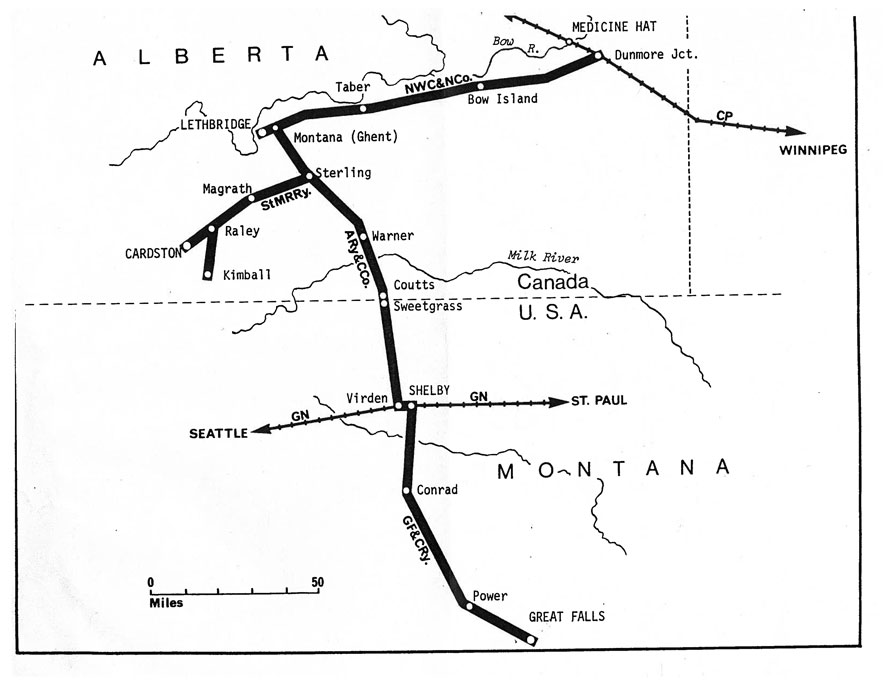
Despite his company’s auspicious beginnings, the economic depression of the late 1880’s struck the Galt family’s Lethbridge-based North Western Coal and Navigation Co. (NWC&NC) hard, almost as soon as it went into full production. The Company needed new markets immediately if it was to survive to the turn-of-the-century. Fortunately, they were successful in capturing new customers, such as the emerging copper and steel smelters in the state of Montana and the American railway giant Great Northern (GN), all of which required huge amounts of coal. To service these new clients, NWC&NC needed a new railway link. In 1889, the Great Falls & Canada Railway (GF&CR) was incorporated in the United States and the parent company, Alberta Railway & Coal Company (AR&CC), in Canada. AR&CC built the 65 miles of narrow gauge track southward from Lethbridge to the border, while the GF&CR built 134 miles of narrow gauge track northward from Great Falls to meet it. Construction began in March 1890, and exactly 108 days later, the AR&CC and GF&CR construction teams met at the new border crossing of Coutts, AB and Sweetgrass, MT. Coutts was named after a major shareholder of the AR&CC, the Baroness Burdett-Coutts, who was one of the wealthiest women in the United Kingdom, right after Queen Victoria! She was also a philanthropist, and helped her famous friend Charles Dickens by financing of some of his work.
The Station
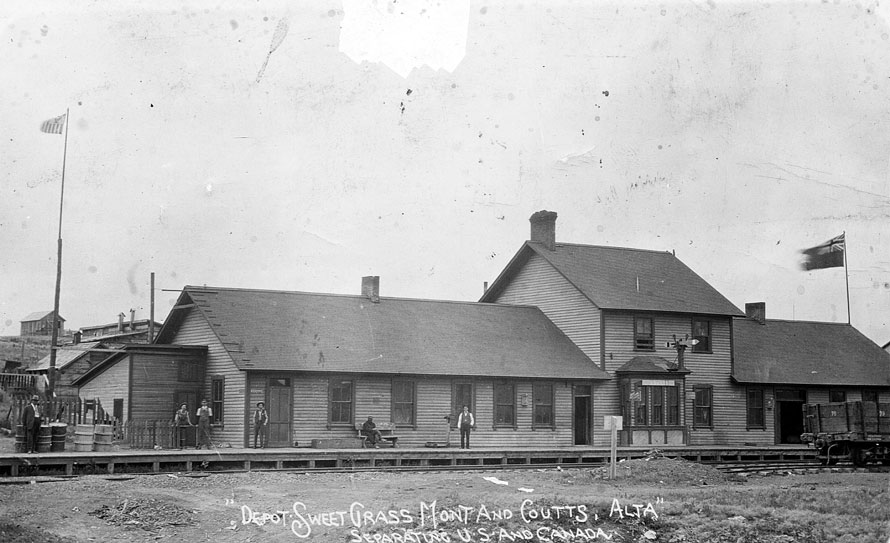
Since the railway crossed the international border, an official port of entry was required, so in June 1890, AR&CC engineer Mr. Barclay and Northwest Mounted Police (NWMP) Inspector John Douglas Moodie chose the site for the location of the 3800 sq. ft. train station. It was situated approximately half in Canada (Coutts) and half in the United States (Sweetgrass).
The actual border ran through the combined waiting and dining room of the station.”
The construction company, run by Donald Grant (one of the investors in the Great Falls & Canada Railway), brought the building materials up from Fort Benton on bull trains (trains of ox-drawn wagons that were used for haulage in western US). The station, even though it was designed in the Victorian era, was not overly adorned with the typical Victorian character defining elements. The only visible signature of the builder was the use of an angled pattern of profiled tongue and groove siding which was placed below the agent’s bay window. This pattern had been used in the past by Scandinavian craftsmen. Additional research finds that the former Grand Trunk Railway station in Claremont, Ontario had a similar style to the Coutts – Sweetgrass Station. Sir Alexander Galt was a director of the Grand Trunk Railway, so one can infer his experience with Grand Trunk influenced this station design! Ironically, the station itself caused one of the first customs problems at the new port of entry. The customs officer in charge, Edwin Allen, reported in October 1890 that ninety-six feet of the Station was on the Canadian side and twenty-five feet on the American, and that the builder was seeking a refund of $62.93 duty paid to Canada on $478.90 worth of American materials used for construction on the American side! After negotiations, it was decided that Canada would keep the duty and that the railway would reimburse the builder.
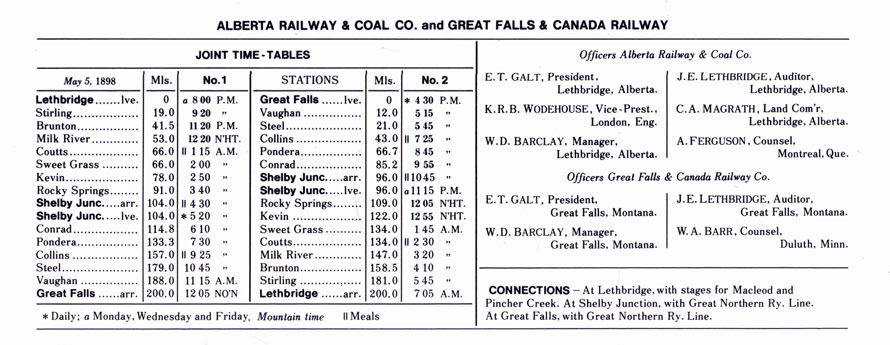
The American portion included a US Customs agent office, a secured baggage room that held items ‘in bond’ while a train was at the station, and a customs area, where US customs agents checked incoming and outgoing passengers. Usually items, such as luggage, were moved behind the station on a boardwalk between the American and Canadian sides and were ‘handed over’ the international border to employees on the other side. The American portion also included two detention cells since there was no jail in Sweetgrass. These were used by the sheriff to detain people who did not have proper identification, or were cattle rustlers, whiskey smugglers, drunks, etc. The actual border ran through the combined waiting and dining room of the station. Outside, the border was marked on the wooden platform by a painted line, which served as an obvious marker for people seeking refuge. One story was told about US law officers chasing a fugitive northward who beat them across the line at the station. Since there was nowhere else to go, the officials decided to wait him out. Taunting the lawmen, the fugitive had food carried to him from the US side and he ate it sitting on the bench on the Canadian side, while the lawmen stood a few feet away fuming!
He brought in one piece of ham and two eggs to satisfy twenty hungry patrons.”
When a correspondent for the Winnipeg Free Press made a lunch stop at Coutts in March 1891, his description of the service provided by the waiter left no doubt that he was not being served by one of the Harvey Girls (refers to waitresses working in Fred Harvey’s high quality chain of railroad restaurants): “The table [in the dining room] bore a strong resemblance to Mother Hubbard’s cupboard, and the waiter did not appear to be in any great hurry. The bill of fare consisted of ham and eggs, and when the waiter made his appearance with the first consignment it was plain to be seen that he was sad and lonesome there by himself, and had been drowning his sorrows at the Sweetgrass Saloon. He brought in one piece of ham and two eggs to satisfy twenty hungry patrons.”
Apparently the passengers devoured the only nourishment available, a portion of a barrel of pickles, and its brine. The cook let the howling mob board the train without paying but insisted the correspondent pay four bits since he was the only one to actually dine! Four months later, following a change in management, a Great Falls bound excursion train was treated to a repast as royal as the correspondent’s meal had been frugal.
Adjacent to the combined waiting – dining room was the stationmaster’s office, where bonded shipments were processed from country to country. There were also the baggage rooms (secured and unsecured), the Canadian customs agent’s office, and the Canadian customs workspace. The station had no jail cells on the Canadian side, as the NWMP detachment was located just up the hill behind the station on AR&CC property.
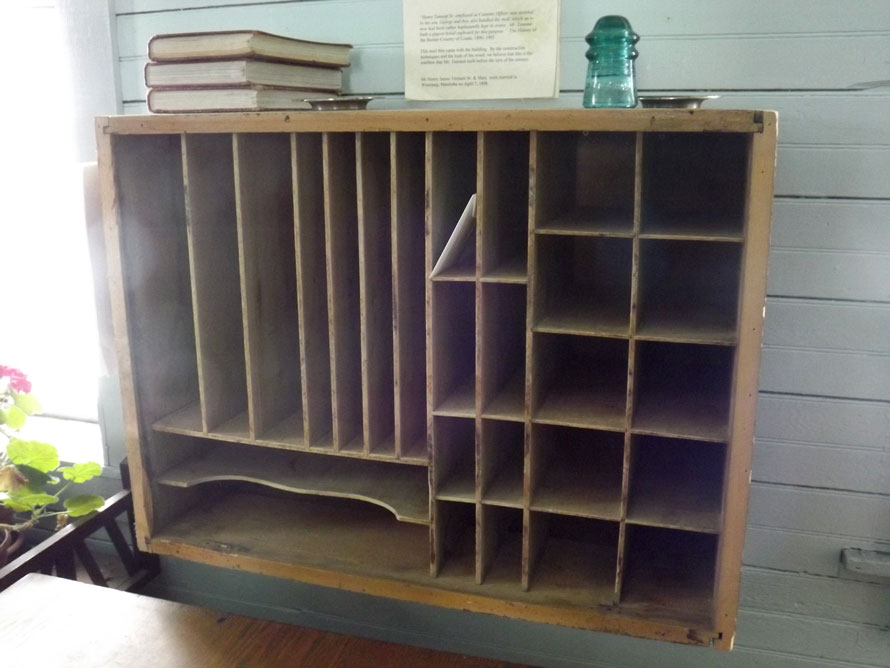
In 1893, Henry Tennant took over as the Canadian customs agent. He was the former Conservative MP for West Lynne, Manitoba, and was also the postmaster, keeping the mail in a homemade box beside his desk, as he was tired of picking up letters and parcels carelessly dumped onto the platform by passing railway employees. The Americans in adjoining Sweetgrass, also picked up their mail from Tennant.
Train Operations
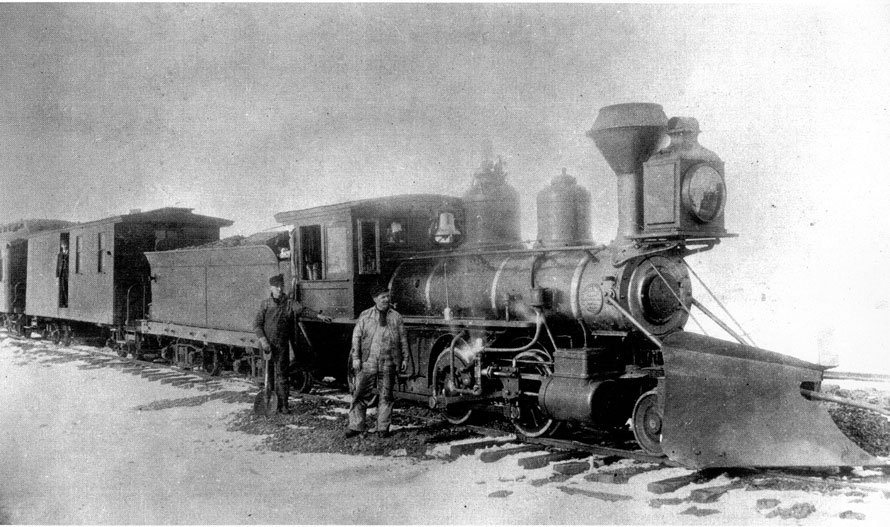
In early October, 1890, the first coal train left Lethbridge bound for Great Falls. Typically, AR&CC train crews operated trains from Lethbridge to Shelby, Montana where GF&CR crews took over to continue the trip southward to Great Falls, and vice-versa. The trip south also included crossing over the newly built Great Northern Railway (GN) east – west standard gauge mainline.
In April 1894, the GN and the Montana Central railroads were paralyzed by labour strikes, leaving the GF&CR the only operating railroad in Montana. To capitalize on the situation, the GF&CR introduced special rates from St. Paul over the lines of the SOO, CPR, and their parent company, the AR&CC. Many of these rates were much lower than GN’s! By 1901, the freight service had been increased to three times per week between Lethbridge and Great Falls, and the weekly delivery of coal to Great Falls had reached 250 tons. At Great Falls, a massive 1000 ft. long by 26 ft. high interchange coal dock had been constructed, parallel to the standard gauge tracks of the Great Northern Railway, so that the self-dumping narrow-gauge cars of the AR&CC and GF&CR could unload their contents into the hoppers of the GN. At this time, Lethbridge coal remained the main source of revenue for this rail line, although passenger traffic was slowly increasing, due to Mormon settlers from Utah who were being hired by the Galt family to help with irrigation efforts in southern Alberta.
By the turn of the century, Montana coal mines began opening up and their cheaper prices threatened the exported Canadian coal market. For instance, one American mine offered to deliver coal to Great Falls customers at $2.50 per ton, while the Canadian Galt price ranged from $8 to $10 per ton! These market conditions forced the Galts to consider getting out of the American railway business. When the Canadian Pacific Railway (CPR) heard about this, they made overtures to buy up the line. However, it would have been a thorn in GN’s side to have a competitor gain direct access into a growing market, so GN acted faster than the CPR and quickly stepped up to the plate and purchased the GF&CR from the AR&CC on August 1st, 1901 at a cost of $750,000. One of the conditions of the sale was that AR&CC had to upgrade the railway line from narrow gauge to standard gauge prior to GN taking over. The upgrading occurred during the remainder of 1901 and into the summer of 1902, with the final takeover by GN happening at the end of October 1902. As a side effect, the AR&CC also had to upgrade their line from Coutts north to Lethbridge, to accommodate the new standard gauge rail traffic from the GN. A third rail was installed along the part of the AR&CC from Stirling to Lethbridge to allow narrow gauge trains to access the St. Mary’s River Railway tracks over the dual gauge section, but that’s another story.
Purchase by CPR
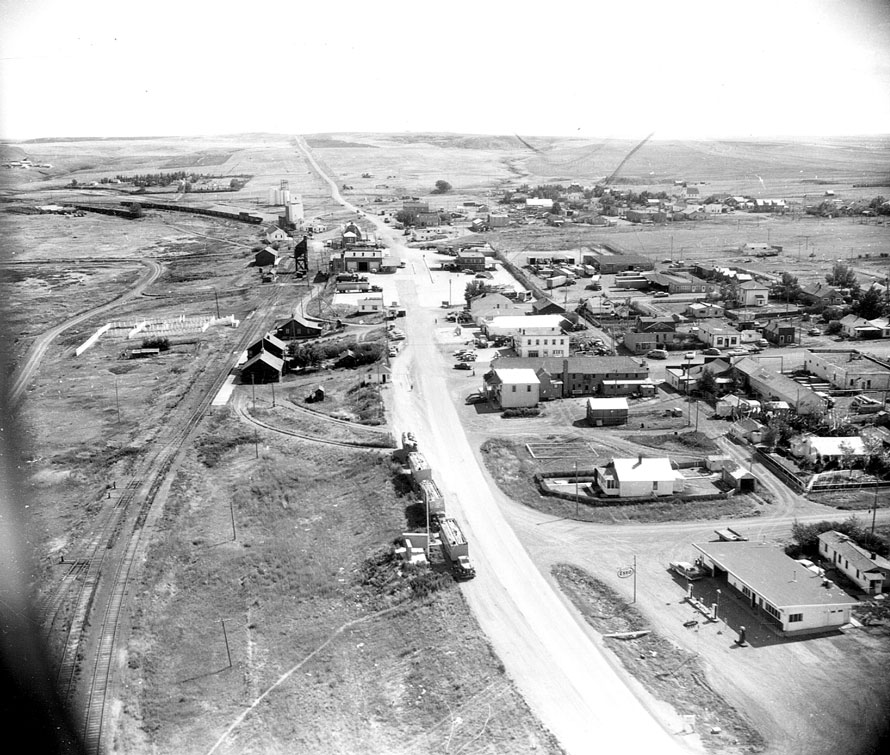
In June 1904, the AR&CC was reorganized and became the Alberta Railway & Irrigation Company (AR&IC). The company continued railway operations until January 1912, when it began negotiations with the CPR to merge with them. This was spurred by the desire of the general manager of the AR&IC, Elliot Galt (son of Sir Alexander), to reduce his work load and slow down. By June 2nd, 1912, the AR&IC became part of the CPR network (under a 999 year lease agreement).
Included in the merger was the Coutts – Sweetgrass Station that was operated jointly by AR&IC and the GN railways. As with the controversy over the GF&CR purchase in 1901, the CPR and GN had a tense relationship in using the same building.
. . . to the surprise of GN officials in Sweetgrass, CPR employees climbed onto the roof of the station and began sawing through it!”
It simmered in the following years and finally boiled over in early September 1916 when, to the surprise of GN officials in Sweetgrass, CPR employees climbed onto the roof of the station and began sawing through it! As the GN officials were hurriedly sending telegraphs to the head office in St. Paul, the CPR crew worked down the walls to ground level. A few teams of horses were hitched up to the front of the station, and after a few tugs it was pulled off the foundations and moved a quarter mile into Canada, leaving a gaping hole in the remaining part of the train station left sitting on the border! Not sure what else to do, GN patched the hole in the old building and continued operations (assisted by two unused boxcars that were commissioned as ‘baggage rooms’). The entire operation was again put to the test a few months later when a blizzard struck the region just as three trains – two northbound and one southbound – were pulling into the station to weather the storm. At Sweetgrass, to keep warm while the snow fell passengers crammed inside the old station or sat outside on the platform huddled around fires burning in barrels. Newspaper journalists from the local Sweetgrass Advocate, and the Great Falls Daily Leader were among the passengers trying to stay warm that night. So the word got out and the negative reviews hit GN hard. The Sweetgrass Advocate reported that – “up to 320 people – men, women, and children, standing on and around the tracks with little bonfires here and there, the thermometer at -6 degrees Celsius waiting at least two hours (and some reported up to five hours) for the train…”
GN Railway built a new Sweetgrass depot in the fall of 1916 after the debacle with the blizzard stranding 3 trains and passengers having to stand outside in the snow. The remaining portion of the original 1890 Galt train station was moved away from the border and on the west side of the tracks, opposite the new depot. The old building was reused as an American customs facility.
The GN passenger depot was renovated in 1953 and continued to serve passengers until it was closed in 1978 and replaced with a small 9 foot by 31 foot metal structure. BNSF uses it as a crew shack currently at Sweetgrass.
The customs building would be used until the spring of 1936 when an new brick building was built. The old building was sold to an local area farmer who carted it away to his farm. We aren’t sure if its still standing.
Later Years
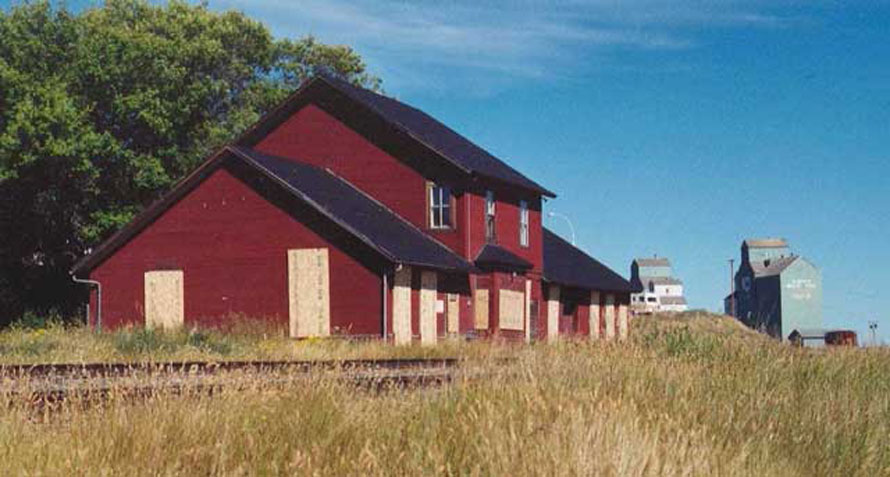
After CPR split the station in two and moved their section north, it continued to be used in that new location until 1986 when stationmaster Cecil Walker retired. It was then operated part-time for three years, until finally closing in 1989. The station sat abandoned until 1998 when the federal government began studies into redeveloping the border crossing at Coutts – Sweetgrass.
The downside to these studies was the recommendation to demolish the station since it stood in the way of the proposed new border crossing. Around this same time, the Great Canadian Plains Railway Society (GCPRS) was formed to tell the story of the railway in southern Alberta with an emphasis on the Galt rail network. Much to the group’s surprise, they discovered that the Coutts station was to be removed. So GCPRS negotiated with the CPR to acquire the station and the ownership was subsequently transferred to the Society in the fall of 1999.
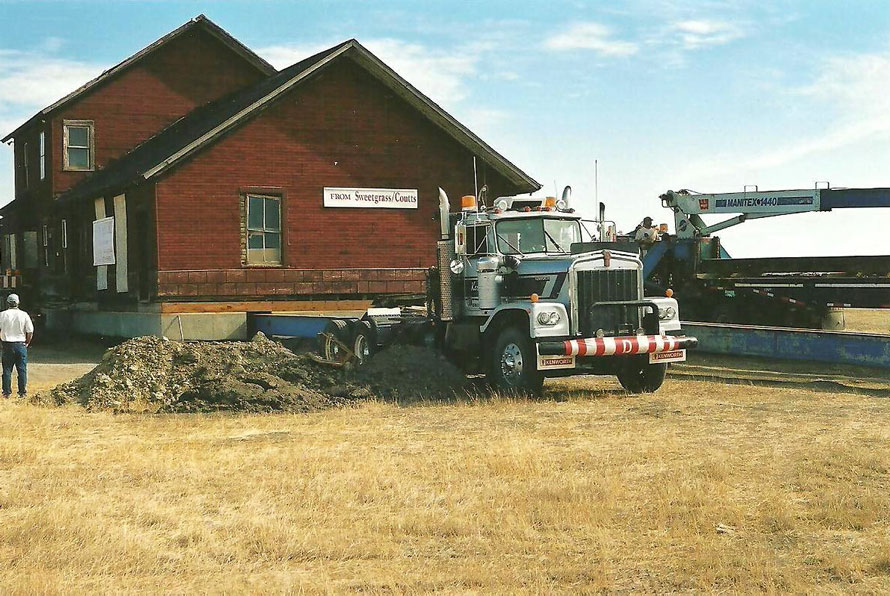
The CPR donated the costs of moving the 90 ton building to the Society’s recently purchased property north of the Village of Stirling along Highway 4 (roughly halfway between Coutts and Lethbridge). Over a two day period in June 2000, the station was carefully lifted and hauled northward to the new site. Included in the move were two CPR bunkhouses. Society volunteer labour, correctional centre work crews, and a one-time provincial centennial grant helped with the renovations of the 1890 portion of the station and the recreation of the American end from photographs and survey plans. By the fall of 2005, it was officially opened to the public
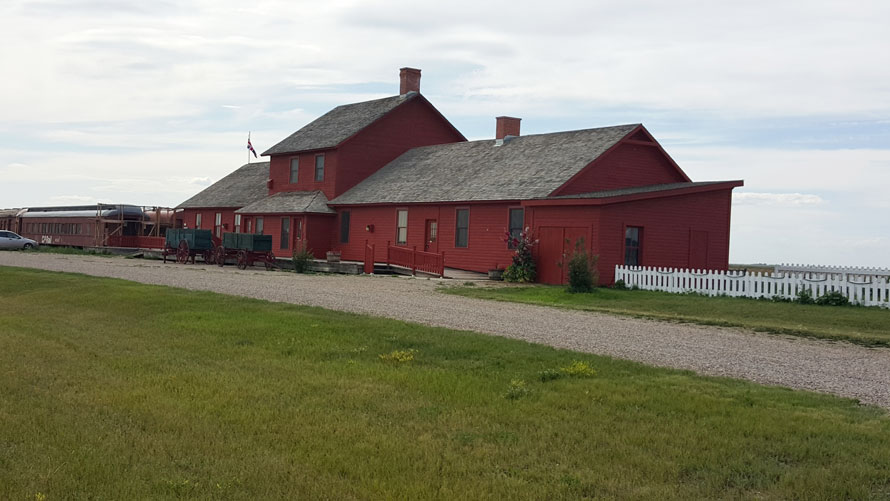
Since then, the Galt Historic Railway Park has added new exhibits of donated railway equipment and a turntable. But the jewel of the crown is the 126 year old international train station, the only one of its kind in Western Canada!
Jason Sailer – Text and photographs Copyright 2017
Acknowledgements I would like to thank Gord Tolton, Chris Doering, and Bill Hillen for making this article possible. Any comments or additional information can be submitted to gcprs@telus.net. Be sure to check out our webpage at galtrailway.com
Great story Jason! I didn’t know that CPR cut the station in two!!!
Jason, terrific article. It is so important to preserve these interesting historic photos and the stories that go with them. Thanks for the time and effort that went into producing this great piece.
Thanks Bob! Its a labor of love, and I am glad I was introduced to this place. I love volunteering in this unique building and telling the story to visitors. When people come to me with stories of their relatives travelling through the station in years past it is especially interesting to hear them and it is important (in my opinion) that their stories be recorded and re-told.
Jason, this is another fantastic article. My father grew up over in the Sweetgrass Hills near Gold Butte. His father is said to have worked on the narrow guage between Great Falls and Shelby. In addition, I know that my grandmother traveled by train from Ontario around 1898 and then returned there to have her second child in 1904 and returning to her family at Gold Butte. I would love to include this article as part of our family history as it explains everything so well. I will wait to hear from you. Thanks for the fantastic article.
Yes by all means Christine, let me know if you need anything. Thank you for sharing your story!